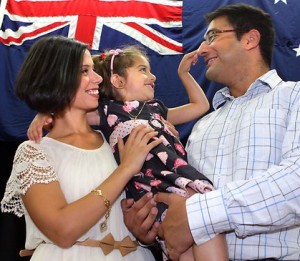Migrant couples a fix for skills shortage
 A new research project will look into how Australia can better utilise the talents and qualifications of spouses of the 190,000 skilled migrants who come here each year.
A new research project will look into how Australia can better utilise the talents and qualifications of spouses of the 190,000 skilled migrants who come here each year.
The research has been commissioned in a bid to help solve the nation’s looming skills shortage and help improve migrant women’s economic security.
Federal Minister Assisting the Prime Minister for Women, Senator Michaelia Cash today announced $100,000 in funding for a research project to investigate the barriers to employment for migrant women from culturally and linguistically diverse backgrounds.
The announcement was made at a Refugee Week event celebrating 25 years of Australia’s Women at Risk Programme.
Senator Cash said she was pleased to be supporting research into the barriers to employment for migrant women.
“It is important for Australia that women migrants are enabled to enter the workforce. Australia’s future economic prosperity is dependent upon a larger, more highly skilled and qualified workforce,” Minister Cash said.
Settlement agency AMES will carry out the research nationally to identify ways to help skilled or tertiary qualified migrant women enter the workforce.
Research shows that by 2020, about 36 per cent of the jobs available in advanced economies like Australia will require workers with either graduate or post-graduate qualifications – up from 24 per cent in 2012.
The Australian Workplace Productivity Agency has identified that Australia will need an increase of 2.8 million people with specific skills over the next decade to fill vacancies in skilled and technical jobs.
On current projections of people completing degrees within Australia, we will not meet this demand. This could mean persistent skills shortages across key parts of Australia’s economy.
AMES CEO Cath Scarth thanked Minister Cash for funding the research, saying it would focus on women’s economic empowerment with a view to creating greater gender equality and economic independence.
AMES lead researcher Lisa Thomson said: “The majority of principal applicants in the skilled migration stream currently are men. But many of the secondary applicants, mostly their spouses, can be just as highly educated as their partner.”
“And we know that economic modelling shows that women arriving on family or partner visas have solid labour force participation that grows over time, but over a 20 year period their contribution to the economy is lower than migrants arriving on a skilled visa,” Ms Thomson said.
“One of the main premises underpinning this research is that Australia’s future economic prosperity is dependent upon a larger, more highly skilled and qualified workforce.
“In order to meet the needs and demands of the economy, Australia needs to be strategic about recruiting skilled workers from overseas. It is not just about filling the immediate needs and shortages; it is about projecting the demand for future skill requirements and building up the workforce.
“If Australia wants to maintain its economic growth, it needs to embraces innovation, emanating from diverse ideas and solutions. Skilled migrants coming to Australia bring a range of different experiences and perspectives. By integrating skilled people who bring a range of experience and credentials garnered outside Australia, this puts businesses in a strong position to innovate.
“From an economic and social perspective, it is important to utilise the human capital that arrives in Australia as part of the migration program. This means employing the skills and capabilities of all family members not just the primary applicant,” Ms Thomson said.
Ms Thomson said employers were already demanding work-ready employees and the demand for highly qualified employees was also driven by an increasing labour market, changing employment composition and retiring baby boomers.
She said research showed three industries with the largest projected increase in the total number of people employed by 2025.
“These are: Health Care and Social Assistance; Professional, Scientific and Technical Services; and, Education and Training,” she said.












